#Labriformes
Explore tagged Tumblr posts
Text


Klunzinger's or Rueppell's Wrasse (Thalassoma rueppellii), family Labridae, order Labriformes, endemic to the Red Sea
Like most wrasses, all of the younger individuals are females, that become male later in life (protogynous hermaphrodite).
photographs: IKER & Dr. Thomas Dörner
#wrasse#fish#bony#thalassoma#labridae#labriformes#ocean#ichthyology#animals#nature#middle east#africa
726 notes
·
View notes
Text

A male slingjaw wrasse (Epibulus insidiator)
by Alain Feulvarch
#slingjaw wrasse#wrasses#bony fish#fish#epibulus insidiator#epibulus#labridae#labriformes#actinopterygii#chordata
2K notes
·
View notes
Text
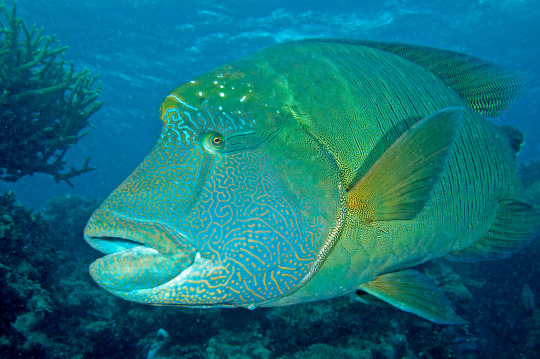


Let's Hear it for the Humphead Wrasse
The humphead wrasse, Cheilinus undulatus, is also known as the Māori wrasse, Napoleon wrasse, or the blue- tooth grouper. They can usually be found around coral reefs and steep rocky cliffs in the Indo-Pacific, particularly on the east coast of Africa, the west coast of India, and the tropical waters of southeast Asia and the Great Barrier Reef.
The Māori wrasse gets its name from the distinctive markings that adults carry. Males are blue-green or purple, while females are more often red or orange. Both have unique patterns of lines and dots covering their heads, and stripes running down the rest of their body; early researchers compared the patterns on their heads to the tattoos traditionally used by the Māori people. In addition to its striking coloration, C. undulatus is also known for being the largest member of the wrasse family. Males can reach up to 2 m (6.5 ft) long and weigh up to 180 kg (396 lbs), while females tend to be smaller. Males also have a large 'hump' on their foreheads, hence the name humphead wrasse.
Another feature of note in C. undulatus is the set of large teeth fused into a parrot-like beak. They use this beak to predate upon hard-shelled animals like mollusks, urchins, sea stars, and crustaceans. On occasion, they also feed on smaller fish and moray eels. Due to their size, adults have very few natural predators aside from sharks, but larvae and small juveniles are more often opportunistically hunted by other fish.
Like many coral reef fish, the humphead wrasse is a protogynous hermaphrodite. This means that most individuals begin life as a female, and become male later in life-- known as 'super males', they are larger than males who did not transition. Individuals first become sexually mature at 5-7 years old, and females begin transitioning to male at 9-12 years old. Spawning occurs a few times a year, and during this period over a hundred adults can congregate in an area. The female releases about 20 eggs into the water column, where they are fertilized by her chosen partner. Three to four weeks later, the eggs hatch and the larvae migrate to the nearby reef.
Conservation status: C. undulatus is considered Endangered by the IUCN. Populations have declined due to overfishing and by-catch mortalities, loss of their food sources, habitat destruction, and capture of juveniles for the aquarium trade.
If you send me proof that you’ve made a donation to UNRWA or another organization benefiting Palestinians– including esim donations– I’ll make art of any animal of your choosing.
Photos
Andrew J. Green
Lluís Masuet
George Ryschkewitsch
#humphead wrasse#Labriformes#Labridae#wrasses#ray-finned fish#bony fish#fish#marine fauna#marine fish#coral reefs#coral reef fish#indian ocean#Pacific Ocean#indo-pacific#animal facts#biology#zoology#ecology
109 notes
·
View notes
Text
Taxonomy Tournament: Fish
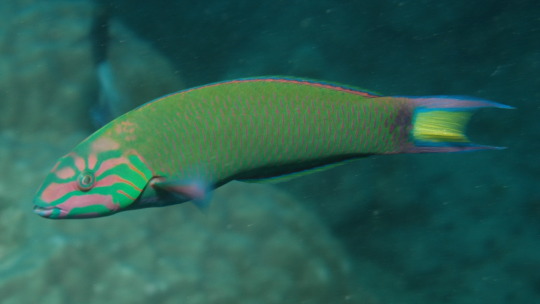
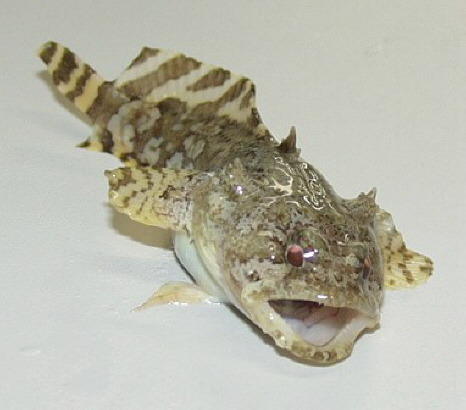
Labriformes. This order contains parrotfish and the cleaner wrasse, which feeds off of parasites they remove from larger fish
Batrachoidiformes. This family is made up of toadfish, ambush predators that hide on sandy and muddy substrates. They also ''sing'' using their swim bladder to attract mates.
#animals#biology#polls#poll tournament#zoology#cleaner wrasse#parrotfish#fish#toadfish#Labriformes#Batrachoidiformes#0x4cv0xb3#animal tournament#Animal Tournament Round 1
83 notes
·
View notes
Text

#Thalassoma quinquevittatum#Thalassoma#Labridae#Labriformes#Actinopterygii#Chordata#fivestripe wrasse#wrasse#fish#wildlife#nature#animal#creative commons#indonesia
3 notes
·
View notes
Text

Cleaner-wrasses and goatfish By: Douglas Faulkner From: The Fascinating Secrets of Oceans & Islands 1972
#cleaner wrasse#wrasse#labriform#bony fish#fish#goatfish#perciform#1972#1970s#Douglas Faulkner#The Fascinating Secrets of Oceans & Islands
151 notes
·
View notes
Text

Range: Waters around New Zealand
#poll#Class: Actinopterygii#Order: Labriformes#Family: Labridae#Genus: Pseudolabrus#Pseudolabrus Miles
22 notes
·
View notes
Text










Physcia dubia
Powder-tipped rosette lichen
I was helping a student learn to ID a common species of Physcia today, and was explaining the characteristics he needs to look out for, and at the end he was like "OK, so with all those things, there isn't another common lichen I can mix it up with, right?" Oh kid, I don't know how to tell you this, but even weathered, old lichenologists find IDing this genus so tricky as to name a species P. dubia (doubtful) to cover their ass if it turns out to not actually be a new species. This particularly dubious little fellow has an irregular or orbicular, foliose thallus that grows in patches up to 3-5 cm across. It has narrow, semi-attached lobes with a gray upper surface, pale margins, and a whitish lower surface. It has labriform (lip-shaped) soralia at the palmate lobe tips. Apothecia are uncommon, and have a sorediate margin and dark brown disc. P. dubia has a broad range and is common throughout the northern hemisphere, and has even been found at the southern edge of South America. It colonizes acidic rock and nutrient-enriched bark in urban and natural locales. Probably. Who can be sure, really.
images: source | source | source
info: source | source | source
#lichen#lichens#lichenology#lichenologist#mycology#ecology#biology#fungi#fungus#symbiosis#symbiotic organisms#algae#phycology#Physcia dubia#Physcia#trypo#trypophobia#I'm lichen it#lichen a day#daily lichen post#lichen subscribe#taxonomy#systematics#dubious delimitation#go outside#look for lichens#life science#environmental science#natural science#nature
100 notes
·
View notes
Text







Klunzinger’s wrasse (Thalassoma rueppellii) themed UFO cuff!!! I don’t usually do asymmetrical designs like this, it was fun!
Fish photo from here: https://www.tumblr.com/herpsandbirds/779293633302200320/klunzingers-wrasse-thalassoma-rueppellii
#my crafts#diy#kandi#kandi making#my kandi#kandi bracelet#kandi cuff#klunzinger’s wrasse#fish#thalassoma rueppellii
69 notes
·
View notes
Text

New "Pokecology" poster has the locomotion types of swimming pokemon ...fin and flipper, anguilliform, carangiform/thunniform, labriform...then there's Sharpedo and Clawitzer who use JET PROPULSION
5 notes
·
View notes
Text

Slippery Dick (Halichoeres bivittatus), family Labridae, order Labriformes, found in the tropical western Atlantic
Like many wrasses, this fish is a protogynous hermaphrodite, starting life as a female, and becoming male later in life.
photograph by Florent Charpin
955 notes
·
View notes
Text
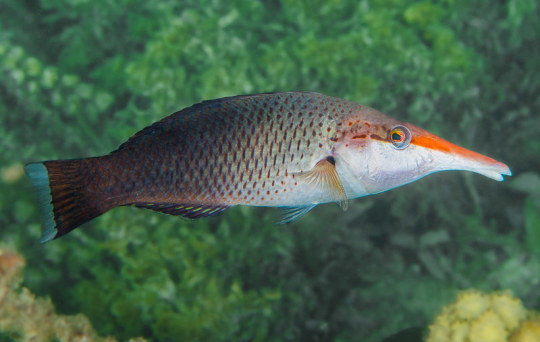
A female Pacific bird wrasse (Gomphosus varius) in Tahiti, French Polynesia
Though this individual is female now, bird wrasses undergo sequential hermaphroditism, and may become male later in life
by François Libert
#bird wrasse#wrasses#bony fish#fish#gomphosus varius#gomphosus#labridae#labriformes#actinopterygii#chordata#wildlife: tahiti#wildlife: oceania
184 notes
·
View notes
Text

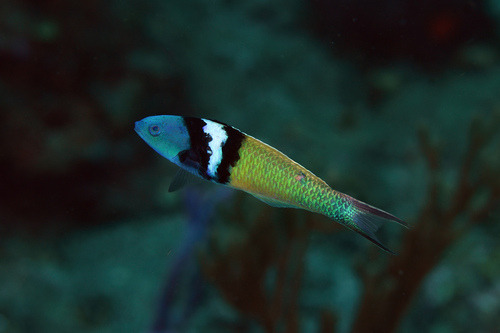
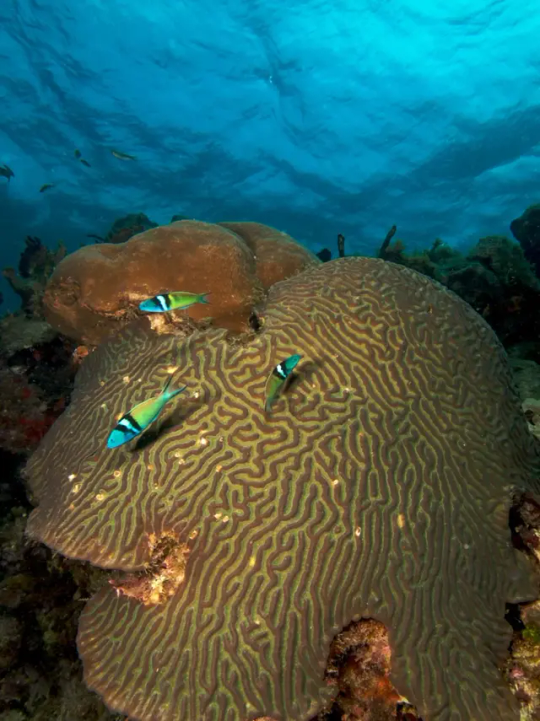
Once in a Blue Moon: The Bluehead Wrasse
The bluehead wrasse (Thalassoma bifasciatum) is a small species of wrasse found only in the western Atlantic Ocean; particularly around the Caribbean and the northern coast of South America. They inhabit coral reefs, and occasionally along sandy bottoms and sea grass meadows. Bluehead wrasse prefer shallow, warm, clear water and reefs with lots of hiding places that they can easily access.
T. bifasciatum is noted for its bright coloration. Females and small males are bright yellow with a white underbelly, while larger males have a greenish body and a blue head, seperated by thick black and white stripes. These large males are typically 7-8 cm (2.7-3.1 in) in length, while smaller males and females are around 6 cm (2.3 in).
Like many coral reef fish species, the bluehead wrasse engages in protogyny. All eggs hatch as females, and as they mature some change into males. These young males, known as initial phase (IP) males, continue to resemble females but are fully capable of reproduction. Eventually, the largest of them transition into a secondary phase, also known as the terminal phase (TP). TP males carry the characteristic blue and green markings of bluehead wrasse, and are significantly larger. The transition from female to IP, IP to TP, or even directly from female to TP can occur at any time, and is particularly triggered by removal of dominant (TP) males from a population.
Reproduction typically occurs from January to August, though it can continue sporadically throughout the year. Mature adults participate in group spawns, in which females and both male types converge at spawning sites. Males compete for proximity to females, and typically TP males will closely guard access to a harem of 30-50 females, while IP males will attempt to use their coloring to sneak in and mate surreptitiously. T. bifasciatum are broadcast spawners; both sexes release their gametes into the water column, where they are fertilized and carried away by the current.
Eggs spend 6-8 months free floating, sometimes drifting miles from their spawning grounds. After hatching into juveniles (larvae), they burrow into the sand and remain there for several months before emerging to seek out a coral reef in which to shelter. At this point, a year after hatching, they are typically mature and ready to mate themselves. Individuals can live up to 3 years in the wild, though juvenile mortality is high.
Bluehead wrasse are cleaner fish. The majority of their food are parasites picked off of larger fish, as well as shrimp, krill, crustaceans, and plankton gathered from the coral itself. However, they are also often food themselves for larger fish, moray eels, and stingrays.
Conservation status: The IUCN considers the bluehead wrasse to be Least Concern. Their primary threat is habitat loss due to coral reef bleaching.
If you like what I do, consider buying me a ko-fi!
Photos
Doug Perrine
Terence Zahner
Nick Hobgood
#bluehead wrasse#Labriformes#Labridae#wrasses#ray-finned fish#bony fish#fish#marine fauna#marine fish#coral reefs#coral reef fish#atlantic ocean#queer animals#queer fauna
46 notes
·
View notes
Text
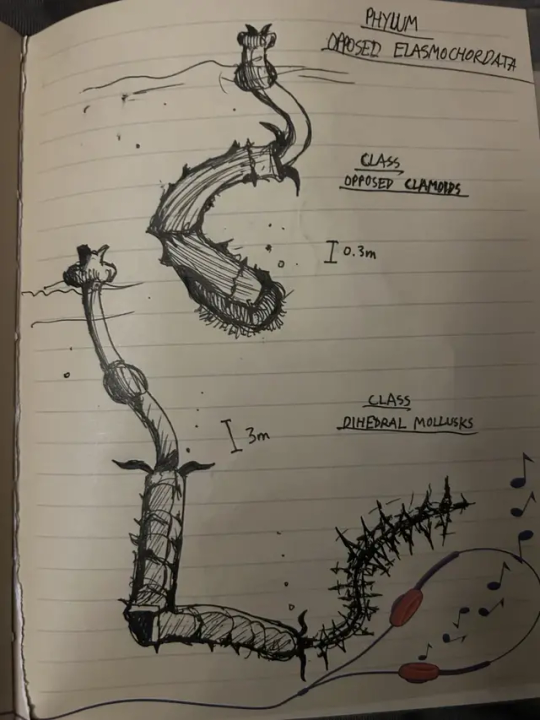

Fifth Phylum !!111! Opposed Elasmochordata STILL in Superphylum Near Bilateral !!
PHYLUM OPPOSED ELASMOCHORDATA
Phylum containing a bidirectional, plated, segmented nerve column and an exoskeleton of calcium carbonate.
(AN1 A2-c) Clade: Chamatae
A clade of opposed elasmochordates that contain a calcium carbonate shell, respirate with an active muscle valve, and locomote via ciliary or muscular valve locomotion.
Class Opposed Clamoids
Class of chamatae that consume organisms through a baleen-analagous filter located on one of the valve ends of the opposition.
Class Dihedral Mollusks
Class of chamatae that consume organisms with an extending tooth-barbed muscle located on one of the valve ends of the opposition.
(AN1 A2-d) Clade: Findopseudopescadae
A clade of opposed elasmochordates that contain an enamel shell, an interior support structure of hyaline cartilage, respirate with pseudo-gill structures, and locomote via water jet excretion or rotation.
Class Walking Steeples
Class of findopseudopescadae that have a semi-flexible exoskeleton, 3-4 long and rigid appendages, a central dorsal node head lined with sensing pili, and are completely benthic.
Class Bifin Aquatics
Class of findopseudopescadae that have a flexible outer shell, 2 ends ending in forked or lunate fins, and use labriform locomotion to swim in pelagic environments.
You may have noticed two things with these guys ! First of all, they are split down the middle! The head end of the nerve column ends at two tails ends as opposed to one. This allows for both enhanced growth and sensing, a splitting and managing of different tasks (most observable on the opposed clamoids and dihedral mollusks) and also redundancy in the event of a predator attack! These guys are also "elasmochordata", which means their nerve chord is segmented into many plates that can be bent and stretched, acting as both a "spine" and a "nerve cord" that can be separated into different functions (similar to how each vertebrae of a mammal can control different body systems)
The second thing you may have noticed is that there are quite a lot of phyla ending in "cord" or "chordata", while on Earth Chordates are just ONE phylum. Well, on Jom'Gol, these different creatures have had a longer period of time to differentiate and speciate-- they are already distinct enough on phylogenetic records. However, the physical differences are very unique as well ! Each type of "nerve cord" has a different time, material, shape, growing structure, and placement that it develops in during the embryo-- and although some creatures may look similar, even an inspection of the spinal cord both during adulthood will show wildly different shapes between phyla!
#art#digital art#artists on tumblr#worldbuilding#jomgol#spec bio#spec evo#speculative biology#speculative evolution#speculative zoology#speculative worldbuilding#creature design#creature
12 notes
·
View notes
Text
she should have specialized in labriformes
need an OC that's really into fish taxonomy
5 notes
·
View notes
Text

Lyretail wrasse By: Unknown photographer From: The Grolier Illustrated Encyclopedia of Animals 1994
#moon wrasse#wrasse#labriform#bony fish#fish#1994#1990s#The Grolier Illustrated Encyclopedia of Animals
125 notes
·
View notes